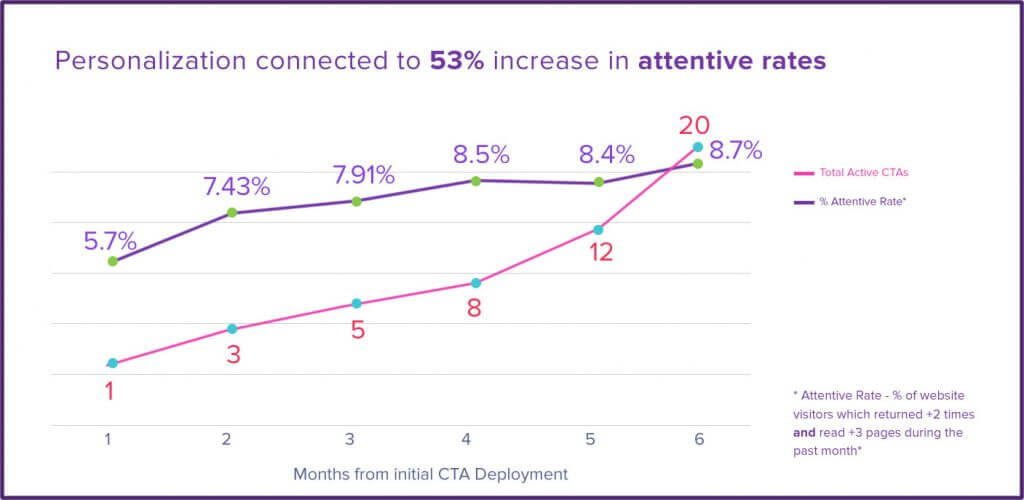How does personalization affect attentiveness? New data shows a clear connection

Over the past months we have been witnessing the migration of entire B2B business processes from offline to online. Field sales have transformed into inside sales and field marketing into digital. In our recent webinar, we discussed some of those transformations. We showed how Account-based marketers are finding new ways to engage target accounts online as well as leverage personalization.
A major cornerstone of that transition process is the website. It’s more important than you may think. Your website is becoming a central hub for revenue generation processes. It affects all stages of the customer journey, from initial awareness to retention and expansion efforts.
As a company’s digital assets grow, so does the need to find new, more sophisticated ways to attract and engage relevant website visitors. So, how do you do that?
We have the answer.
Personalized Calls-to-action (CTAs) = more attentive website visitors
Personalization leads to a more attentive audience. A recent analysis we’ve conducted among websites running our personalization units shows a positive correlation between the number of personalization units (mostly, calls-to-action) and the percent of attentive website users. We define attentive users as those that completed reading 3 or more pages and visited the website twice or more over a 30-day period. We’ve found these attentive users are strongly associated with completing later and deeper business goals, such as becoming opportunities or closed-won deals. Instead of just looking at general traffic figures, analyzing the attentive user base is a helpful proxy to gauge how successful digital efforts truly are.

In just over 4 months, we can see that as the number of CTAs deployed rose, so did the website’s attentiveness rate. This indicates that personalization units can play an important role, not only in increasing in-session engagement (reduce bounce rates and time on site), but also in increasing the number of sessions of users over time.
Nice.
This paper from McKinsey agrees, further exemplifying how personalization will likely become one of the most important assets for marketing success in the next five years. And with the effects of Covid-19, these trends will only accelerate.
Types of CTAs and Personalization
In the above cases, marketers made smart use of targeted calls-to-action that lead their target audiences down specific conversion paths. The majority of unit layouts used were either lightbox popups, usually triggered upon the user’s exit intent, or embedded personalized CTAs nested within the articles themselves.
Beyond layout, segmenting and thoughtfully targeting audiences created better attentiveness. This way, prospects, existing opportunities or customers weren’t offered irrelevant content. For example, existing users from opportunities were not prompted to speak to a sales rep, but rather offered relevant case studies to their unique industry.
Key Takeaways
Address the Key Stage:
Consider the experiences your website delivers to visitors in all major stages of their journey, from top of funnel awareness content and calls to action to mid and bottom of funnel calls to action aimed at more intent level stages. Adding specific messages for users across those stages will not only help engage them during the session, but will also increase the likelihood of them returning to your site.
Save Gates for the Later Stages:
It’s important to make your content accessible, especially for top of funnel and awareness level audiences. Gate only deeper, more intent level items. This has a dual benefit. First, it increases the engagement rates of new audiences with your content (since they don’t need to submit personal information). Second, your Sales Department will thank you. You’ll reduce the amount of noise for the team. No more chasing non-relevant or too early contacts.
Quantity has Quality:
The more personalized CTAs and targeted activation campaigns you are running on your site, the higher your chances of engaging a relevant prospect. The more of these “micro-segments” you can create, target and serve, the higher your outputs on your website. We see this especially in cases of ABM activities. CTAs which target specific companies or industries have higher CTRs and get higher quality leads. The ability to show only case studies of Pharma or Finance to visitors from those companies enables capturing more of the attention of those prospects.
A final word of caution – This should not be confused with overwhelming your website visitors with pop-ups and messages which can only interrupt their experience and lower attention rates.
If you’re interested in exploring other topics, check out how to attribute content marketing, how to measure content marketing ROI, or how to carry out effective B2B account-based personalization (ABM) campaigns.